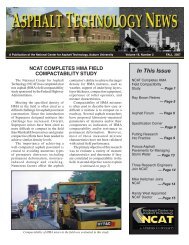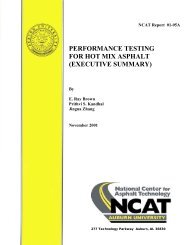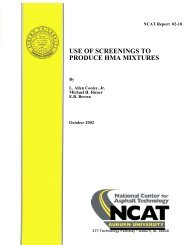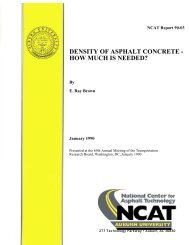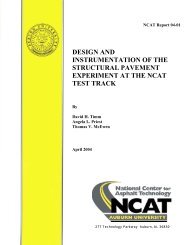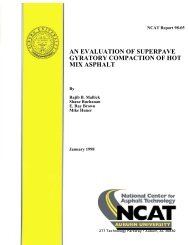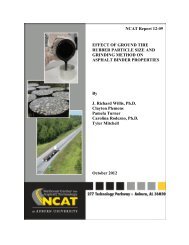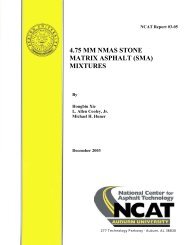A Review of Aggregate and Asphalt Mixture Specific Gravity ...
A Review of Aggregate and Asphalt Mixture Specific Gravity ...
A Review of Aggregate and Asphalt Mixture Specific Gravity ...
Create successful ePaper yourself
Turn your PDF publications into a flip-book with our unique Google optimized e-Paper software.
Objective <strong>and</strong> Process <strong>of</strong> the <strong>Review</strong>EXECUTIVE SUMMARYVolumetric properties are currently used for design <strong>and</strong> acceptance <strong>of</strong> hot-mix asphalt(HMA) mixtures. Vital to the calculation <strong>of</strong> mixture volumetric properties is theconversion <strong>of</strong> mass percentages to volume proportions/percentages using specific gravitymeasurements <strong>of</strong> the mixture <strong>and</strong> the aggregates in the mixture. The accuracy <strong>and</strong>reliability <strong>of</strong> the specific gravity measurements are therefore fundamental to the business<strong>of</strong> building quality asphalt pavements.A task group consisting <strong>of</strong> the authors under the direction <strong>of</strong> the Federal HighwayAdministration (FHWA) <strong>Asphalt</strong> Mix <strong>and</strong> Construction Expert Task Group was tasked toconduct a critical review <strong>of</strong> specific gravity measurement methods. The objectives <strong>of</strong> thisreview were to summarize problems <strong>and</strong> issues with current methods, examine possibleimprovements <strong>and</strong>/or alternate methods, <strong>and</strong> identify areas that need further research <strong>and</strong>development.This review separately examined three specific gravity determinations, namely, the bulkspecific gravity <strong>of</strong> the aggregates (G sb ), the maximum specific gravity <strong>of</strong> asphalt mixtures(G mm ), <strong>and</strong> the bulk specific gravity <strong>of</strong> compacted specimens (G mb ). The review drawsupon information from research studies, state transportation departments, AASHTO <strong>and</strong>ASTM st<strong>and</strong>ards, <strong>and</strong> the AASHTO Materials Reference Laboratory (AMRL). The view<strong>of</strong> the task group has been that change(s) to the current specific gravity methods may bemotivated by one or more <strong>of</strong> the following three reasons:1. The change(s) or new method(s) will provide specific gravity results closer to thetruth (i.e., greater accuracy),2. The change(s) or new method(s) will yield more repeatable results (i.e., betterprecision), <strong>and</strong>3. The change(s) or new method(s) will be faster, easier, <strong>and</strong>/or less expensive.FindingsThe primary st<strong>and</strong>ard test methods for determining the bulk specific gravity <strong>of</strong> coarseaggregates are AASHTO T 85 <strong>and</strong> ASTM C127. Disadvantages <strong>of</strong> these methods include(1) the inconsistency <strong>of</strong> the visual method for determination <strong>of</strong> the SSD condition; <strong>and</strong>(2) the required soak time <strong>of</strong> at least 15 hours. These disadvantages are addressed inalternative methods for determining G sb <strong>of</strong> coarse aggregates, including the vacuumsealing procedure (i.e., the commercially available CoreLok device). Recent studiesshowed that the vacuum-sealing method produced higher G sb values that weresignificantly different (both statistically <strong>and</strong> practically) from those determined byAASHTO T 85, especially for highly absorptive coarse aggregates. In addition, thevacuum-sealing <strong>and</strong> AASHTO T 85 procedures had similar reproducibility.With respect to the determination <strong>of</strong> bulk specific gravity <strong>of</strong> fine aggregates, the primaryst<strong>and</strong>ard test methods are AASHTO T 84 <strong>and</strong> ASTM C128. Disadvantages <strong>of</strong> these testi




